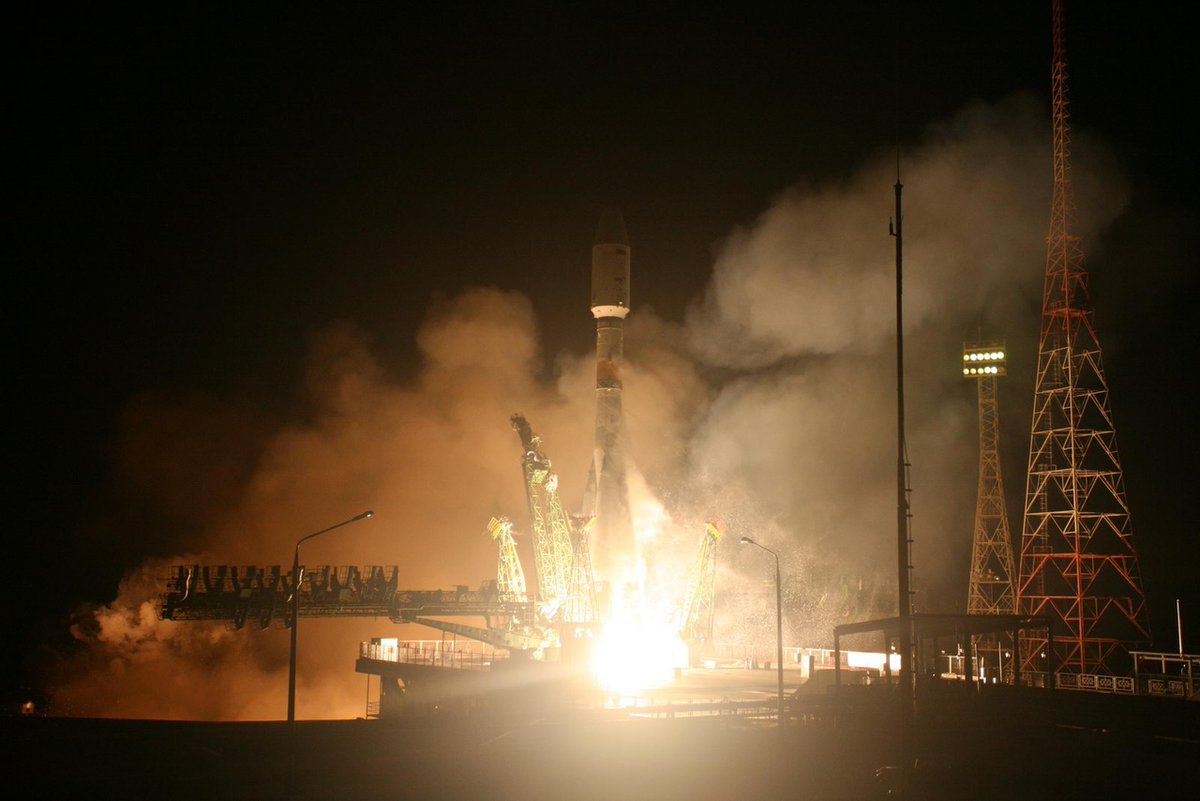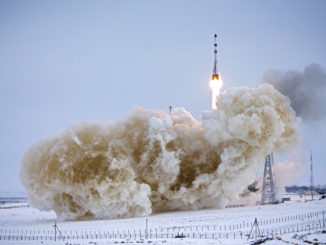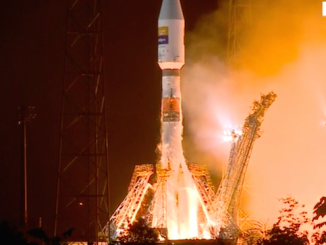
A Soyuz rocket, with the help of a Fregat upper stage, delivered an Egyptian Earth observation satellite into a polar orbit at an altitude of more than 400 miles (650 kilometers) Thursday, overcoming an apparent technical problem after launching from the Baikonur Cosmodrome in Kazakhstan, according to Russian news reports.
The Soyuz-2.1b rocket lifted off from pad 31 at Baikonur at 1647 GMT (11:47 a.m. EST; 9:47 p.m. local time) with EgyptSat-A, a remote sensing satellite built by Russia’s RSC Energia aerospace manufacturer to provide the Egyptian military and other government agencies with high-resolution surveillance imagery.
Energia and Roscosmos, the Russian space agency, confirmed the Soyuz-2.1b rocket and its Fregat upper stage delivered the EgyptSat-A spacecraft into the planned orbit. U.S. military tracking data indicated the mission deployed the satellite into an orbit more than 400 miles above Earth, at an inclination of 98 degrees to the equator.
But Russian news reports suggested the mission may have experienced a close call during the climb into orbit.
Russia’s Tass news agency reported the EgyptSat-A satellite and its Fregat upper stage were tracked in a lower-than-expected orbit after the three-stage Soyuz booster deployed the rocket’s upper unit around nine minutes after liftoff.
But Tass reported that burns by the Fregat upper stage appeared to have corrected the apparent performance shortfall, which may have occurred during the third stage’s engine firing. The Fregat upper stage was expected to ignite twice to deliver EgyptSat-A to its intended orbit.
The RIA Novosti news agency also reported the launcher was observed in a lower-than-planned during Thursday’s flight, attributing the information to two space industry sources.
In the end, Russian officials said EgyptSat-A was released at the expected altitude, and the solar panels on the satellite unfurled as designed.
The Soyuz-2.1b variant of Russia’s venerable Soyuz rocket family uses a different upper stage engine than the version used for crew launches. The Soyuz-2.1b uses a four-nozzle RD-0124 engine, while the Soyuz-FG and Soyuz-2.1a configurations employ a RD-0110 third stage engine.
The next Soyuz crew launch, with two NASA astronauts and a Russian cosmonaut heading for the International Space Station, is scheduled for March 14.
The next launch of a Soyuz rocket carrying satellites was scheduled for Feb. 26 from French Guiana, a commercial mission under the management of the French launch provider Arianespace. That flight is slated to use a Soyuz ST-B rocket, a variant that uses the same third stage design as the Soyuz-2.1b launcher that flew Thursday with EgyptSat-A.
The upcoming launch from French Guiana was pushed back at least 24 hours until Feb. 27 to allow engineers more time to review data from the EgyptSat-A launch, according to Greg Wyler, founder and chairman of OneWeb, which plans to launch its first six broadband satellites on the Soyuz.
“At least (a) one day slip for the launch,” Wyler tweeted late Thursday. “Ugh. Glad to see EgyptSat-A launch was successful, but need to review more data on that launch before proceeding. Waiting patiently.”
Thursday’s Soyuz flight with EgyptSat-A was Russia’s first space launch of the year.
EgyptSat-A replaces the EgyptSat 2 Earth-imaging satellite, which failed in orbit in 2015, one year into a planned 11-year mission. The EgyptSat-A satellite was manufactured with money from an insurance payout from the loss of EgyptSat 2, according to Tass.
Russian news reports said the development of EgyptSat-A cost approximately $100 million.
The satellite weighs more than a ton fully fueled, and Tass reported EgyptSat-A features several improvements over the EgyptSat 2 design, including improved solar batteries and a high-speed radio link with ground stations.
The spacecraft’s electro-optical imaging system includes an Earth-viewing telescope and camera that can spot surface features as small as 3.3 feet (1 meter), with similar capabilities as the failed EgyptSat 2 satellite. EgyptSat-A is the third Egyptian Earth observation satellite built in Russia, following the EgyptSat 1 spacecraft launched in 2007 and EgyptSat 2 launched in 2014.
Like its predecessor, EgyptSat-A is owned by Egypt’s National Authority for Remote Sensing and Space Sciences, a government agency tasked with gathering and studying satellite imagery of the Earth. Primary users of EgyptSat-A’s imagery are expected to include Egyptian military and security forces, intelligence analysts, emergency responders, environmental monitoring experts, and the agricultural sector.
Email the author.
Follow Stephen Clark on Twitter: @StephenClark1.



